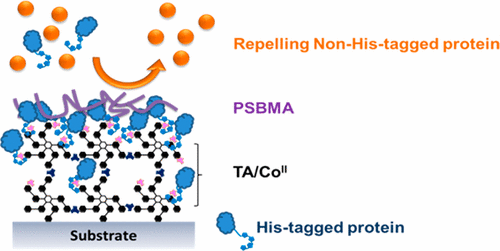当前位置:
X-MOL 学术
›
ACS Biomater. Sci. Eng.
›
论文详情
Our official English website, www.x-mol.net, welcomes your
feedback! (Note: you will need to create a separate account there.)
Facile Oriented Immobilization of Histidine-Tagged Proteins on Nonfouling Cobalt Polyphenolic Self-Assembly Surfaces
ACS Biomaterials Science & Engineering ( IF 5.4 ) Pub Date : 2017-11-02 00:00:00 , DOI: 10.1021/acsbiomaterials.7b00691 Lulu Han 1 , Qi Liu 1 , Liwei Yang 1 , Tong Ye 1 , Zhien He 1 , Lingyun Jia 1
ACS Biomaterials Science & Engineering ( IF 5.4 ) Pub Date : 2017-11-02 00:00:00 , DOI: 10.1021/acsbiomaterials.7b00691 Lulu Han 1 , Qi Liu 1 , Liwei Yang 1 , Tong Ye 1 , Zhien He 1 , Lingyun Jia 1
Affiliation

|
In this study, a completely green and facile protocol to oriented immobilization of histidine-tagged (His-tagged) proteins based on plant polyphenolic tannic acid (TA) is described. This is the first time that TA has been applied as ionic chelators to immobilize His-tagged proteins. To reduce the nonspecific interactions between the TA and immobilized proteins, we assembled nonfouling zwitterionic poly(sulfobetaine methacrylate) (PSBMA) on the TA surface. The use of PSBMA could maintain the high activity of the His-tagged proteins and inhibit the adsorption of untagged protein to the TA surface. Subsequently, the obtained TA/PSBMA film was further chelated with CoII for specific binding to a His-tagged protein. As CoIII is more stable and inert than CoII, the chelated CoII was oxidized to CoIII. Using this approach, His-tagged Chitinase was anchored to TA/PSBMA/CoIII film as a catalyst for the hydrolysis of chitin. The loading capacity of the film for the His-tagged Chitinase can reach ∼4.0 μg/cm2. Moreover, the oriented immobilized Chitinase had high catalytic activity and excellent thermal and storage stability as well as being more resistant to proteolytic digestion by papain. This low-cost and green protein-oriented immobilization strategy may serve as a versatile platform for a range of applications, such as biomaterials, biocatalysis, sensors, drug delivery, and so on.
中文翻译:

组氨酸标记的蛋白在不结垢钴多酚自组装表面上的定向固定化
在这项研究中,描述了基于植物多酚鞣酸(TA)定向固定组氨酸标签(His标签)蛋白质的完全绿色且简便的方案。这是首次将TA用作离子螯合剂来固定His标记的蛋白。为了减少TA和固定蛋白之间的非特异性相互作用,我们在TA表面组装了不结垢的两性离子聚(甲基甜菜碱甲基磺酸甜菜碱)(PSBMA)。PSBMA的使用可以保持His标记蛋白的高活性,并抑制未标记蛋白吸附到TA表面。随后,将获得的TA / PSBMA膜进一步与Co II螯合以与His标记的蛋白特异性结合。由于Co III比Co II更稳定和惰性,螯合的Co II被氧化成Co III。使用这种方法,将His标记的几丁质酶固定在TA / PSBMA / Co III膜上,作为水解几丁质的催化剂。膜对His-标记的几丁质酶的负载能力可以达到约4.0μg/ cm 2。此外,定向的固定化几丁质酶具有高的催化活性和优异的热稳定性和储存稳定性,并且更耐木瓜蛋白酶的蛋白水解消化。这种低成本且面向绿色蛋白质的固定化策略可以用作多种应用程序的多功能平台,例如生物材料,生物催化,传感器,药物输送等。
更新日期:2017-11-03
中文翻译:

组氨酸标记的蛋白在不结垢钴多酚自组装表面上的定向固定化
在这项研究中,描述了基于植物多酚鞣酸(TA)定向固定组氨酸标签(His标签)蛋白质的完全绿色且简便的方案。这是首次将TA用作离子螯合剂来固定His标记的蛋白。为了减少TA和固定蛋白之间的非特异性相互作用,我们在TA表面组装了不结垢的两性离子聚(甲基甜菜碱甲基磺酸甜菜碱)(PSBMA)。PSBMA的使用可以保持His标记蛋白的高活性,并抑制未标记蛋白吸附到TA表面。随后,将获得的TA / PSBMA膜进一步与Co II螯合以与His标记的蛋白特异性结合。由于Co III比Co II更稳定和惰性,螯合的Co II被氧化成Co III。使用这种方法,将His标记的几丁质酶固定在TA / PSBMA / Co III膜上,作为水解几丁质的催化剂。膜对His-标记的几丁质酶的负载能力可以达到约4.0μg/ cm 2。此外,定向的固定化几丁质酶具有高的催化活性和优异的热稳定性和储存稳定性,并且更耐木瓜蛋白酶的蛋白水解消化。这种低成本且面向绿色蛋白质的固定化策略可以用作多种应用程序的多功能平台,例如生物材料,生物催化,传感器,药物输送等。











































 京公网安备 11010802027423号
京公网安备 11010802027423号